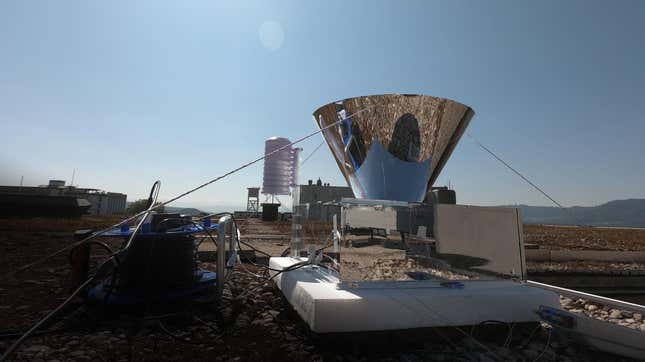
As we look towards a Waterworld-esque future where our access to H20 is increasingly rare, it’s even more important to figure out how to squeeze every last drop we can, including out of thin air. In a study published Wednesday in Science Advances, a team of researchers from ETH Zurich demonstrated a new way to create drinking water from humid air.
There are lots of powerful atmospheric water generators on the market. But they still rely on technologies like fans that need external power. Passive water collection systems, meanwhile, are time-limited: They generally only work at night, when humidity is higher, and the water is in danger of evaporating back into the atmosphere when the sun comes up. There’s been a recent surge in techniques that use trays of materials, like gels, metals, salts, and other compounds to collect water when humidity is higher at night; the material is then naturally heated by the sun and releases the water it has collected. The downside of this technique, however, is that it’s not 24/7, and it’s not automatic. The team of researchers wanted to bypass all these systems’ various issues.
“We said, let’s try something that really doesn’t require any energy, so it’s really energy neutral and only limited by physical principles,” said Iwan Hächler, a PhD student at ETH Zurich and the lead author of the study. “We thought, ‘what if we show we can evaporate water? What if we try to condense it using radiative heat or radiative energy?’”
The resulting design is deceptively simple–it looks basically like a wide cone placed on top of a box, with a glass pane at the narrow end of the cone on top of the box. Each component here plays a key role.
Condensation happens when water in the air comes in contact with a surface that is below the ambient temperature. To ensure this process happens, researchers coated the glass pane with polymer and silver, allowing it to reflect the sunlight back and keep itself cooler than the ambient temperature. On the underside of the pane is a special coating where moisture from the air can collect and drop without requiring human or mechanical help. The cone acts like a radiation shield, which keeps the device from overheating and deflects the heat energy created from the condensation process.
“True condensation creates a tremendous amount of heat, because of the phase change of the water from gaseous to liquid,” said Hächler. “So we designed a radiation shield, which boosted the performance to allow us to get bigger yields.”
The design works pretty well, Hächler said. In lab tests, the maximum yield his team was able to get from the device was 0.05 liters (1.8 fluid ounces) per square meter per hour, very close to the theoretical maximum yield that researchers had calculated. That means the device is able to practically produce around 1.2 liters per square meter per day, or about a third of a person’s required daily intake. This is around twice the output of some other passive technologies, the researchers said.
One of the biggest pluses of this system is that it is pretty easy and cheap to set up. Hächler said that the special coating that eliminates the water-wiping action isn’t totally needed to make the system function, while the silver coating on the glass pane would probably work just as well with any super-reflective surface, like chalk or white paint.
“We made a joke that we should make a version with cardboard and aluminum, but we could,” said Gabriel Schnoering, a postdoctoral fellow studying thermodynamics at ETH Zurich and another coauthor of the study. “Maybe not the same performance, but the idea works with glass, cardboard, aluminum.”
The possibilities for a device that could just sit there and create water for days on end are, pretty big. The climate crisis is causing dry places to become even drier. In other locations, groundwater reserves are being depleted at an unsustainable level. While the system alone couldn’t meet the needs of a region like the entire western U.S., which is currently in a megadrought and facing water restrictions, it could still play a role in helping address shortages there or other parts of the world that are water stressed.
Hächler said the system could be easily coupled with desalination. The air near the surface of the ocean is pretty humid, so desalination systems “could just let [the device] float around” and do its job. And it opens up possibilities for people living in poorer or remote areas without steady power who need more water.
“You could imagine installing it on a roof for families, and they could get some potable water,” he said.
Update, 6/23/21, 3:35 p.m. ET: We have added a link of Kevin Costner pissing in a container to make the Waterworld analogy a little clearer. We also suppose this post could work with Mad Max in the lede. Either way, we’re screwed.
Correction, 6/24/21, 8:25 a.m. ET: We’ve updated this post to correct the positions of Iwan Hächler and Gabriel Schnoering and clarifying language about the trays of materials technique and the harvesting process with the new technology.